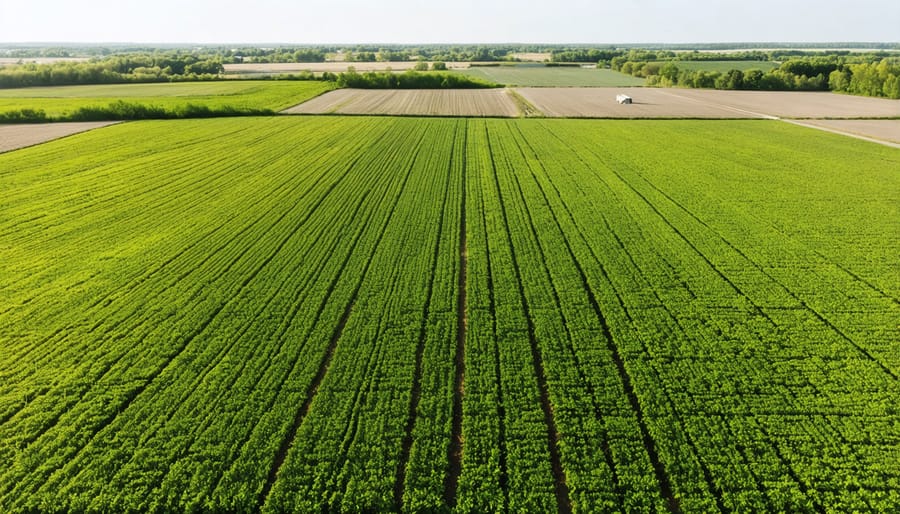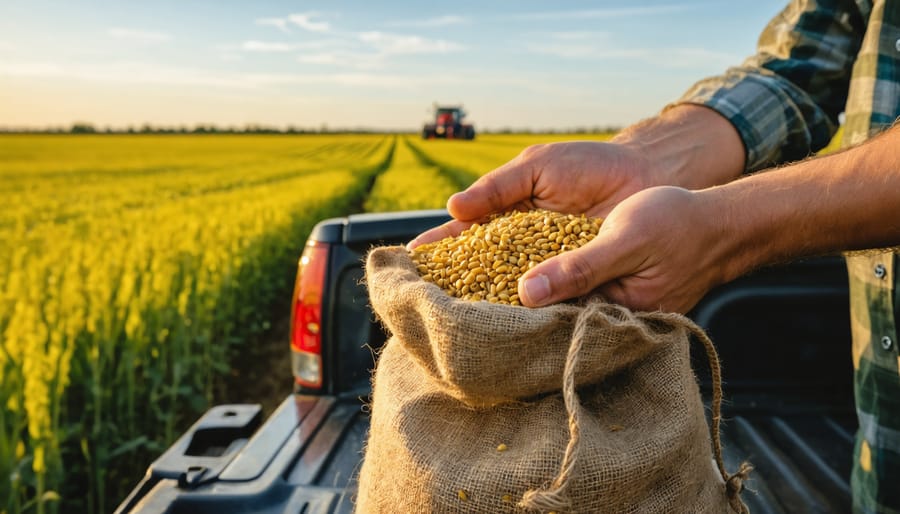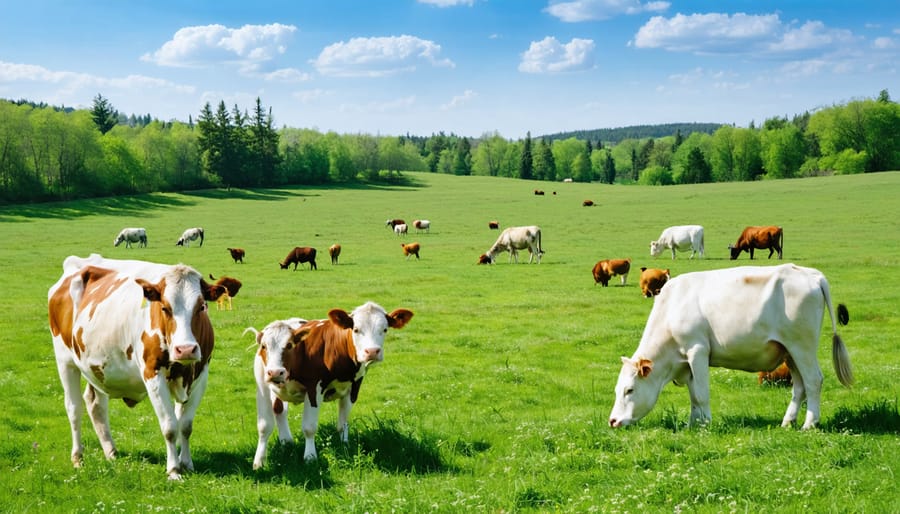Organic farming’s relationship with pesticides challenges common misconceptions about chemical-free agriculture. While organic certification strictly regulates synthetic pesticides, Canadian organic farmers can effectively use approved biological and mineral-based pest control methods to protect their crops. Natural solutions like neem oil, copper sulfate, and beneficial insects work alongside preventive measures such as crop rotation and soil health management to create resilient farming systems. Understanding these approved pesticide options helps Alberta farmers maintain organic certification while ensuring sustainable crop yields and meeting growing consumer demand for organic produce.
The careful balance between pest management and organic principles reflects modern agriculture’s evolution toward environmentally conscious practices. By following Canadian Organic Standards, farmers can protect their investments using permitted substances that align with organic farming’s core values of soil health, biodiversity, and ecological balance. This approach demonstrates how organic agriculture adapts traditional wisdom to contemporary challenges, offering practical solutions for pest control without compromising organic integrity.
Approved Pesticides in Canadian Organic Farming
Natural vs. Synthetic Pesticides
When it comes to pest management in organic farming, there’s often confusion about what distinguishes natural from synthetic pesticides. The key difference lies not just in their origin, but in how they’re processed and their impact on the ecosystem. Natural pesticides are derived directly from plant, mineral, or biological sources, while synthetic pesticides are manufactured through chemical processes.
In organic farming, the use of approved organic pesticides is carefully regulated to maintain ecological balance. For example, neem oil, derived from neem tree seeds, is commonly used by Alberta farmers to control insects while preserving beneficial organisms. Similarly, diatomaceous earth, a natural sedimentary rock, effectively manages crawling pests without introducing synthetic chemicals into the soil.
The approval process for organic pesticides focuses on several key factors: their natural origin, minimal processing requirements, and their ability to break down without leaving harmful residues. Substances like pyrethrum (from chrysanthemum flowers) and copper sulphate (a naturally occurring mineral) are permitted because they align with organic farming principles.
However, it’s important to note that “natural” doesn’t automatically mean “safe.” Each substance, whether natural or synthetic, must be used responsibly and in accordance with Canadian organic standards. The goal is to find solutions that protect crops while maintaining soil health and biodiversity. Many Alberta farmers have successfully integrated these natural alternatives into their pest management strategies, often combining them with cultural and biological control methods for optimal results.

Compliance with Canadian Organic Standards
For Canadian farmers pursuing organic certification, understanding and following the organic certification requirements is crucial when it comes to pest management. The Canadian Organic Standards (COS) provides a comprehensive framework that outlines permitted substances and practices for organic farming operations.
Under the COS, farmers must first implement preventive pest management strategies, including crop rotation, beneficial insect habitat creation, and soil health optimization. Only when these methods prove insufficient can approved organic pesticides be considered as a last resort.
The Permitted Substances Lists (PSL) within the COS specifically outlines which substances organic farmers can use. These include naturally derived pesticides such as neem oil, diatomaceous earth, and Bacillus thuringiensis (Bt). Each substance comes with specific conditions for use and documentation requirements.
Here in Alberta, organic farmers must maintain detailed records of any pest control substances used, including the justification for application, quantities, and dates. These records are essential during annual inspections by certification bodies.
It’s worth noting that the standards are regularly updated to reflect new research and evolving best practices. Currently, the COS requires a 36-month transition period during which farms must follow organic practices before achieving certification. During this time, farmers should work closely with their certifying body to ensure all pest management practices align with current standards.
Local certification bodies like Pro-Cert and OCIA Alberta Chapter provide guidance and support to help farmers navigate these requirements while maintaining effective pest control strategies that preserve the integrity of organic production.

Alberta Success Stories: Natural Pest Management
Case Study: Prairie Organic Farm
Located just outside of Red Deer, Alberta, Prairie Organic Farm has become a model for successful natural pest management in Canadian agriculture. Owner Sarah Thompson transitioned her 200-hectare farm to organic practices in 2015, implementing a comprehensive integrated pest management strategy that combines companion planting, beneficial insects, and approved organic pesticides.
Thompson’s approach focuses on prevention first, using crop rotation and resistant varieties of wheat and canola. When pest pressures emerge, she employs targeted applications of neem oil for aphid control and Bacillus thuringiensis (Bt) for cabbage moth management. These natural solutions have helped maintain crop yields while meeting organic certification requirements.
“The key is monitoring and timing,” explains Thompson. “We’ve reduced our pesticide use by 75% compared to conventional methods by understanding pest life cycles and maintaining healthy soil ecology.” Her farm has maintained consistent production levels, averaging 2.5 tonnes per hectare for organic wheat, while building a thriving ecosystem that naturally suppresses pest populations.
The farm hosts regular workshops for local farmers interested in organic transition, sharing practical insights and real-world solutions for pest management challenges.

Documentation and Record-Keeping Requirements
Maintaining accurate records is crucial when using organic pesticides on your farm. Every application must be documented as part of your organic certification documentation, ensuring transparency and compliance with Canadian organic standards.
Keep a detailed spray log that includes:
– Product name and active ingredients
– Application date and time
– Weather conditions during application
– Target pest or disease
– Crop and field location
– Application rate and method
– Name of the certified applicator
Store all purchase receipts, product labels, and safety data sheets in a dedicated folder. Many Alberta farmers are now using digital record-keeping apps specifically designed for organic operations, making it easier to track and report pesticide use during inspections.
Document your integrated pest management (IPM) strategy, showing that organic pesticides are used only when other control methods have been insufficient. Include monitoring records, threshold levels, and prevention measures implemented before pesticide application.
Keep these records for at least five years, as required by certification bodies. Regular review of your documentation helps identify patterns in pest pressure and evaluate the effectiveness of your organic pest management program. Consider joining local organic farming networks to share best practices for efficient record-keeping systems.
Transitioning to organic farming while managing pests effectively is a journey that requires careful planning and dedication. As we’ve explored, certified organic farms in Canada have access to numerous approved pesticides that align with organic principles, from biological controls to mineral-based solutions. The key is developing an integrated pest management strategy that prioritizes prevention and uses permitted substances only when necessary.
For Alberta farmers considering organic certification, the path forward starts with connecting with your local organic certifying body and developing a detailed transition plan. Consider joining organic farming associations and networking with experienced organic producers in your area who can share valuable insights. Remember that successful organic pest management relies on building healthy soil, promoting biodiversity, and maintaining thorough documentation of all practices and inputs.
Take advantage of available resources through provincial agricultural extension services and organic farming organizations. Start small by converting a portion of your land first, allowing you to gain experience while minimizing risk. With proper planning and implementation of the practices we’ve discussed, you can successfully manage pests while meeting organic certification requirements and contributing to Canada’s growing organic agriculture sector.










